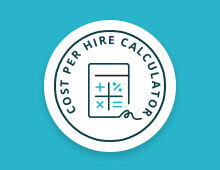Qualified job candidates per hire: recruiting metrics that matter

How and what we need to measure in recruiting remains an active discussion. While there is plenty of data on offer from key recruitment metrics, interpreting that data in a way that will improve your hiring process is complicated. Take an in-depth look at these key performance indicators (KPIs) that are worth tracking in recruiting.
What’s the definition of qualified candidates per hire?
The number of candidates who make it past the first stage of your hiring process
This is one of the best recruiting metrics because it that tracks your overall recruitment marketing. This relatively simple number tells you how many of the candidates you sourced, or who applied for your job, are worth an initial conversation. In Workable’s default hiring pipeline (which our customers customize to their own preferred stages) this means a candidate who was moved from “sourced” or “applied” to the “promising” or “call” stage.
For this to happen a member of the hiring team has to have checked the candidate’s profile, which includes their resume, answers to questions on an application form, as well as publicly available social and professional profiles, and decided they were worth talking to or having other team members evaluate.
In sales terms, the qualified candidate is equivalent to the qualified lead.
Qualified candidates per hire is a spot check on the health of your sourcing and advertising strategies, as well as the effectiveness of your employer brand. If there’s something amiss in one of these three it will quickly turn up in the qualified candidates per hire metric.
Benchmarking qualified candidates per hire
| Qualified per hire (job function) | US average | UK & Ireland | Rest of Europe | Rest of world |
| Customer Service | 24 | 23 | 17 | 20 |
| Engineering | 40 | 26 | 29 | 49 |
| Healthcare | 15 | 14 | 7 | 15 |
| Human Resources | 63 | 50 | 30 | 42 |
| Information Technology | 40 | 28 | 32 | 41 |
| Marketing | 53 | 39 | 40 | 46 |
| Product Management | 55 | 46 | 40 | 56 |
| Sales | 35 | 32 | 32 | 25 |
| Other | 26 | 25 | 28 | 26 |
How to benchmark your recruiting metrics
Just as there is a wide variance between industry and area be aware of the variance between different jobs in the same industry. Benchmarks should be used as a starting point to ask useful questions about your hiring process, not as an absolute measure of what is a complex process.
Nonetheless, if your numbers are completely out of touch with industry benchmarks or other businesses in your location, here are some things you should consider to improve your qualified candidates per hire:
- The first step is to delve into your job advertising. Cross reference your Qualified candidates per hire with a candidate source report. If you’re using paid job boards, check which ones are bringing you qualified candidates. Double down on the sources that are working for you. Cut your spend on those that aren’t. If you’re using free job posting sites, it may be time to increase visibility using a premium job board.
- Revisit your sourcing strategy. Does your recruiting team (or whoever is doing the recruiting for you) properly understand the role you’re hiring for? Could you do a better job of describing the role? If you’re not sourcing enough candidates, is is time to add to your recruiting team?
- If you’re not getting enough qualified candidates, your job descriptions could also be at fault. Make sure you’re writing about the job in a way that will appeal to the kind of people you’re looking for.
- Review your recruiting budget to ensure that you’re spending in the most effective recruiting channels.
The top recruiting KPIs
The recruiting metrics that matter:
- Time to fill: The planning metric
- Time to hire: The efficiency metric
- Interviews per hire: The process metric




